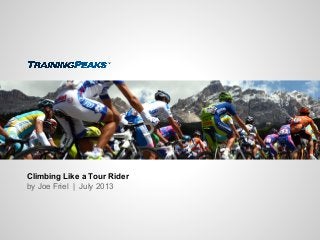
Climbing Like a Tour de France Rider
- 1. Climbing Like a Tour Rider by Joe Friel | July 2013
- 2. “You can't fake it in the mountains. Either you can climb or you're dropped. That's it. Bottom line." © 2013 TrainingPeaks. All rights reserved.
- 3. Too Much Mass? Gravitationally challenged We weren't all born to be climbers. The best climbers: ● Are typically shorter and lighter than average ● Tend to have 2.0 pounds per inch of height or less ● For a 5'10" athlete, that would only be 140 lbs. ● However, they don't do well on windy, flat courses or flat time trials where gravity plays a small role © 2013 TrainingPeaks. All rights reserved.
- 4. What if you're not 2.0 lbs per inch? It's not all bad news Let's say we have two Cat 3 riders... Rider A Rider B Weight 140 lbs. 185 lbs. Height 70 in. (5'10") 74 in. (6'2") Mass 2 lbs. per inch 2.5 lbs. per inch Threshold Power 300 watts (2.1 w/lb) 360 watts (1.9 w/lb) © 2013 TrainingPeaks. All rights reserved. On a long hill climb: When both climb at their threshold, the one with a higher power output per pound will pull away. -RIDER A WINS On a flat course: Gravity is not a significant factor but wind is. Success in the wind is determined by power-to-frontal area ratio. When both riders are aero, there's only a small difference between small and big riders. Raw power prevails; 360 watts beats 300 watts every time. -RIDER B WINS
- 5. How to Climb Faster
- 6. Reduce Mass One side of the power-to-weight ratio Every kg of excess fat costs you 3 seconds per km on a climb. So, losing 11 excess pounds can make you 3 minutes faster on a 12-km climb! Downsides ● Losing weight mid-season can detract from recovery and training ● Losing the wrong type of weight (muscle instead of fat) will hurt climbing ability ● Weight loss is best done during the winter © 2013 TrainingPeaks. All rights reserved.
- 7. Build Power What can you do right now to improve climbing ability? Build Fitness There's more to climbing than just power and mass. If your muscles fatigue and your lungs burn on every climb, you'll lose ground. The most effective way to become a better climber is to build the right kind of power. “You can have the greatest power-to-mass ratio on the planet and not climb for beans if you have horrible aerobic- anaerobic threshold fitness." © 2013 TrainingPeaks. All rights reserved.
- 8. Hill Cruise Intervals A workout to improve climbing ability ● Find a hill that takes 8-12 minutes to climb ● Look for a 4-6% grade (about the same as an interstate overpass) ● Do 3-5 repeats up the hill keeping your heart rate or power at threshold1 ● Recover only as long as it takes to descend ● Do this workout 1-2x weekly ● You will see measurable improvement in 6-8 of these workouts over a 4- 6 week period 1) Threshold HR or power is your maximum sustainable effort for one hour. © 2013 TrainingPeaks. All rights reserved.
- 9. Technique Seated or Standing? Larger-mass riders (2.3 lbs. per inch or greater) are generally better off staying seated on long climbs. Smaller riders (2.0 lbs per inch or less) generally climb better standing. © 2013 TrainingPeaks. All rights reserved. vs
- 10. Technique Cadence Keep your cadence high even on steep climbs. This takes load off the muscles and increases aerobic-function load Pedal stroke Improve economy with efficient pedaling: ● On the upstroke, keep heels slightly raised above the pedals, even when seated on a climb ● On the downstroke, drop your heels below the pedal © 2013 TrainingPeaks. All rights reserved.
- 11. Mindset Your attitude has to back up the training. ● Work on what's going on between the ears every day ● Remind yourself: Even if you are "2.5", your climbing will improve as a result of all the effort you're putting into it. ● Tell yourself you love the hills, and most importantly... ● Believe! © 2013 TrainingPeaks. All rights reserved.
- 12. Resources For more cycling training advice: Visit the TrainingPeaks blog: blog.trainingpeaks.com For power data from the Tour de France: See TrainingPeaks race analysis: trainingpeaks.com/tdf
